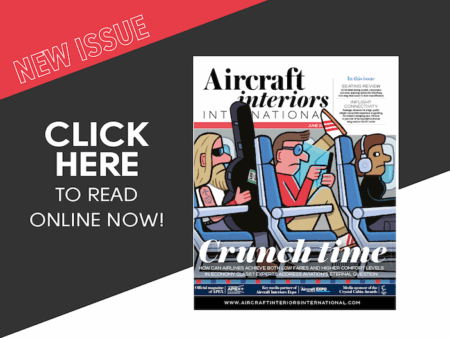The ability to safely access the internet at 30,000ft is becoming commonplace nowadays – even a passenger expectation in some markets. However, as passengers place greater demands on the inflight internet bandwidth, the connected experience could become less of a benefit to the experience and more of a frustration. Fortunately a team in Scotland has devised what they claim is an alternative.
Light fidelity, or Li-Fi, has the potential not only to transform IFE systems, but also to revolutionize cabin and fuselage design, according to its inventor, Harald Haas, professor of mobile communications at the University of Edinburgh.
This state-of-the-art, aviation-friendly wireless technology works by co-opting existing LED light sources to transmit data. As Haas explains, “This technology is perfect for planes as it doesn’t interfere with radio signals in the same way as wi-fi, which uses radio waves. Instead, Li-Fi takes advantage of visible light.
“Li-Fi is a game-changer for three reasons. First, it solves a ‘congestion’ issue. In the data-driven world that we live in, we are running out of radio spectrum. This is a problem in crowded places like airports and aircraft interiors as it means that the current available bandwidth does not support the hundreds of people wishing to use data-intensive applications and the internet in the same place at the same time. Li-Fi solves this issue by using 1,000 times the bandwidth compared with the entire radio frequency spectrum. This is additional free, unregulated bandwidth in the visible light spectrum.
“Second, it paves the way for local-area networks to be established, which means that passengers can make calls, use the internet and access in-flight entertainment systems more easily.
“Third, in a world fast being dominated by big data, safeguarding information is paramount. In the cabin, although Li-Fi signals can leak through windows, the technology offers greater protection to passengers than a wi-fi connection. But the biggest gains will be experienced by OEMs. Their manufacturing halls often have lots of LED lighting and few windows, which will enhance data security in their facilities.”
So how does it work?
Haas says, “There are several hundred lights in a typical aircraft cabin. You’ll find them embedded in the seats, the floor and underneath the overhead lockers,” he explains. “But let’s take the passenger reading lights, for example. Let’s not think of them as lights, but as wireless routers. By harnessing the power of Li-Fi, an aircraft cabin can deliver speeds 300 times faster than an average wi-fi connection.”
However, Haas is keen to issue a caveat around performance. “While any LED light source can be used, to guarantee the fastest speeds, aircraft manufacturers would need to install flexible RGB accent lighting, which requires three chips to create artificial white light for the best results. This lighting is more expensive, but it guarantees speeds of five gigabits per second. In contrast, traditional LED lighting only encodes data at a speed of 100 megabits per second.”
For information to be successfully streamed to devices, the technology, which uses the existing LED infrastructure, requires an internet connection and a photo detector. How do these three components combine to generate ultrafast wireless data transmission speeds?
Say Haas, “In the future the avionics databus system on a plane could be used to stream content to each lighting fixture. Each LED light source would transmit the data at high speed to a passenger’s laptop, tablet or smartphone. Each device would be fitted with a dongle that contains a photo detector and an LED – typically an infrared LED – to send data back to the lighting fixture. The photo detector would capture and process the intensity changes that each LED light produces and convert them back into a digital format that we recognize as the digital content, such as a YouTube video.”

Wider benefits
According to Haas, Li-Fi ensures that passengers don’t have to share radio spectrum, as is the case on current flights. Instead, they will have access to a much higher level of bandwidth. However, the potential of Li-Fi extends far beyond enhancing a passenger’s in-flight entertainment experience.
“Li-Fi will also prove a liberating innovation for the manufacturer, as it largely eliminates the need for copper cabling in the cabin,” says Haas.
Take the Airbus A380, for example, which is one of the largest passenger aircraft on the planet. Within that giant fuselage there are 300 miles of wiring, which as well as being heavy, also takes up valuable passenger and cargo space. So what will the interiors of tomorrow look like?
“I think that in the future, cabins will be much more modular and malleable. In 10 years’ time, almost cable-free aircraft fuselages will allow airlines to temporarily remove entire seating areas and replace them with freight storage zones if passenger demand for a particular flight is low, and vice versa.
“But most excitingly, I believe that Li-Fi will herald the arrival of next-generation cabin designs. If cabling is no longer an issue, aircraft interiors have the potential to become more like the Japanese Shinkansen high-speed trains in their look and feel. Li-Fi opens the way for manufacturers to install larger windows on planes and bold new seating arrangements, where passengers are at last able to face each other.”
So how many years will we have to wait before this exciting vision of the future becomes reality, and what will it cost?
“With rapid integration and miniaturization of Li-Fi modules, I would predict that in the future the cost to implement Li-Fi into airplane cabins would be between £10 (US$12) and £15 (US$18) per unit. Timeframes in the aeronautics industry are difficult to predict because of the long development cycles and involved qualification procedures for equipment that goes into an aircraft. Also it would help if there were a global Li-Fi standard. In this context, it has to be said that Li-Fi is currently being standardized in 802.15.7, and pureLiFi is a major player in this process.” Haas is founder and chief science officer of pureLiFi, a developer of visible light communications technology.
“What’s more, innovations in airline cabin design are traditionally quite conservative and the pace of change slow. However, in the next three years I can see an opportunity for us to retrofit the technology into commercial airliners.”
But with Estonian start-up Velmenni having recently tested a Li-Fi network in an Airbus cabin interior in its Bizlab in Hamburg, is the technology nearer to being realized than Haas thinks?
“In an aviation setting and in general, I strongly believe that pureLiFi is the only visible light communication technology provider that currently offers true Li-Fi technology. We are actively driving the 802.15.7r1 Li-Fi standard. This year pureLiFi released the LiFi-X, which is the smallest, fastest and most secure Li-Fi product in the market. We believe that we are the only company in the world that can deliver an untethered, networked Li-Fi internet connection on a plane.”
And with Apple, the biggest technology company in the world, rumored to be showing a keen interest in this next-generation technology, there is no doubt that the Li-Fi revolution is already underway. Whether or not it will bring about a seismic shift in the way commercial aircraft are designed, however, is far from clear.





